Are you ready to cook and enjoy the most satisfying and heart-warming Japanese hot pot dishes? Known as Nabemono or Nabe, they are the necessary remedy for cold weather. Here you’ll learn the basics on how to prepare nabemono and all the delicious styles of hot pot to make at home.

To combat long winter months or gloomy rainy days, the Japanese embrace the elements by enjoying a wide variety of hot pot dishes called nabemono (鍋物), or simply nabe(鍋).
We believe there’s nothing more comforting than the warmth of hot broths, fresh foods, and the social aspect that nabemono brings forth. They are nourishing, easy-to-prepare kind of food and so fun to eat. No wonder they are wintertime favorites in Japan. If you enjoy hot foods regardless of the season, like me, you can even make nabemono year-round!
Table of Contents

What is Nabemono?
Nabemono is a compound word in which “nabe” (鍋) refers to a cooking pot, and “mono” (物) means things or stuff. The concept of nabe is simple: it involves a mixture of fresh vegetables, meat, seafood, tofu, soybean products, or seasonal ingredients, all cooked in a simmering soup broth in a pot. Some of the popular nabe dishes include Sukiyaki, Shabu Shabu, Yudofu, and Oden — many of which I’ve shared on Just One Cookbook.
In Japan, you can experience these hot pots in specialty restaurants or izakaya that offer various nabemono dishes. From Hokkaido to Kyoto to Fukuoka, there are also numerous regional versions of hot pot throughout Japan, each featuring unique local ingredients, preparations, and different flavors of broth. If you have the opportunity to visit different regions of Japan in the winter months, it is worth tracking down what the local nabe has to offer.
Have you tried any interesting nabe you’d love to share? It is a topic itself and I’d love to talk about it in the future post some days!
The Equipment You Need
1. Donabe Pot

The most important piece of equipment for making nabe is the cooking pot itself. In Japan, various pots are used for different styles of nabe, but the most ideal cooking vessel to prepare all sorts of nabemono dishes at home is a donabe (土鍋).
Made with heavy ceramic to retain and distribute heat, a donabe is a traditional Japanese earthenware pot that is specifically designed to cook hot pot dishes. Donabe comes in many beautiful designs and various sizes. If you plan to cook nabemono regularly, investing in a quality donabe is the best choice! It’s highly versatile and durable.
- Where to buy: Japanese and Asian grocery stores, Japanese ceramic shop, Toiro Kitchen, or Amazon
- Donabe sizes: I recommend a 12 inch (30 cm) donabe for anywhere from 2-6 people servings. You can also get the single pot for 1 serving, with a diameter of 6.5 inches (16.5cm). To feed a bigger crowd (6+), you would need at least two donabe pots.
- How to care for a donabe: When a donabe is properly cared for, it can last for generations. You can read my article on How to Season and Care for Your Donabe.

Alternatives:
- Stainless steel hot pot with divider: There are various styles of stainless steel hot pots available online or at Asian grocery stores. The most common one you can find is a stainless steel hot pot with a divider, which you can make 2 types of soup broth or with spicy and non-spicy options. You can use this hot pot for Chinese, Korean or other Southeast-Asian-style hot pots.
- Electric stainless steel hot pot: If you don’t like to use a gas stove, you can use this electric hot pot with a divider.
- Multi-functional electric skillet: If you prefer the convenience, this multi-functional electric skillet is another alternative to prepare nabemono at home. Since you can use it for sauteing, grilling and cooking soup-based dishes, it makes a great option for college kids or for someone with limited storage space.
- Dutch oven: A heavy pot like a Dutch oven can also be used for nabemono dishes. See how I made Mille-Feuille Nabe.
2. Portable Butane Stove & Butane Gas Canisters

To create a communal dining experience for a nabe dish, you’d need a portable gas burner where everyone can partake in the cooking and eat off the hot pot over an open flame. The majority of donabe require a gas stove, and can’t be used on an electric stove.
Asian families commonly use the portable single burner butane stove for cooking and grilling at the table. It is also an excellent resource for emergency cooking (in case of a power outage!), road trips, or camping.
- Where to buy: I bought my Iwatani portable gas stove (this one looks slightly nicer) on Amazon and stocked up butane gas canisters at Asian grocery stores or Amazon.
- Safety: Burning butane does not normally produce carbon monoxide; however, it’s always a good idea to be aware of ventilation, especially if you’re cooking in a very small area.
3. Cooking Tools for Nabe

Aside from a donabe and portable gas stove, you will need to prepare some cooking tools at the table.
- A fine mesh skimmer and a bowl/measuring cup filled with water so you can skim the broth as you cook.
- A ladle or two to scoop soup broth
- A few slotted ladles to fish out the cooked vegetables and meat from the pot.
- A few pairs of serving (long) chopsticks
- One or two pairs of tongs
- Serving platters
- Individual bowls/plates/chopsticks for everyone
Broth (Hot Pot Soup Base)

The foundation of your entire meal lies in a rich and flavorful broth. Authentic Japanese hot pot recipes typically require a variation of dashi, a Japanese soup stock crafted from kombu kelp, bonito flakes, and dried mushrooms.
The dashi is then combined with a concentrated sauce or used as a base for pork bone broth, chicken broth, seafood, kimchi, tomatoes, or soy milk, depending on the type of nabe.
Common Ingredients for Japanese Hot Pot
A good hot pot is all about balance, so you’ll often find a few food categories. Each style of nabe may feature a different protein, but the basic ingredients are similar and interchangeable.
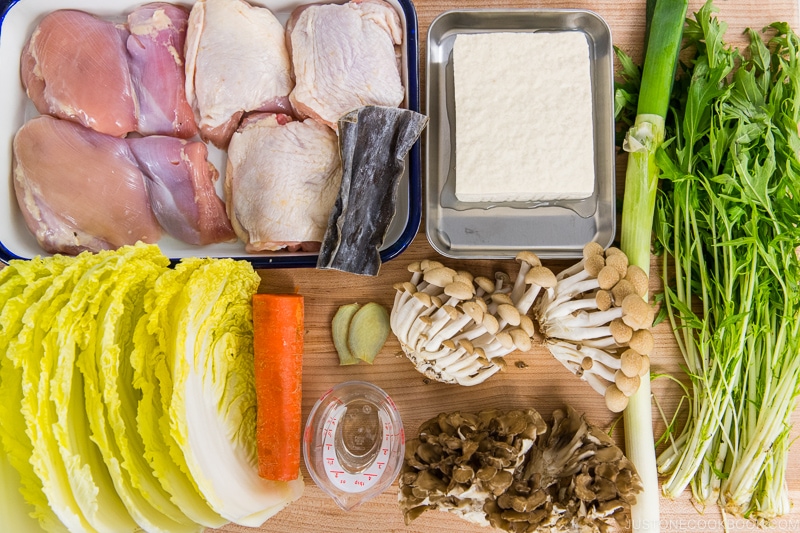
Meat and Seafood
The most typical proteins include thin slices of beef (brisket, short rib, ribeye, sirloin, or flank steak), pork loin or pork belly, and chicken. Chicken meatballs are also used in certain types of hot pots. For seafood-style hot pots, fish (salmon or white fish), shrimp, tempura, or fish cakes are common. You can also use scallops, clams, mussels, or squid.
I usually get my thinly sliced meat at my local Japanese or Korean grocery stores.
Tofu and Soybean Products

Medium-firm tofu, yaki tofu (grilled tofu), egg tofu, or aburaage (deep-fried tofu pouch) are always a favorite in a hot pot regardless of the style.
Vegetables
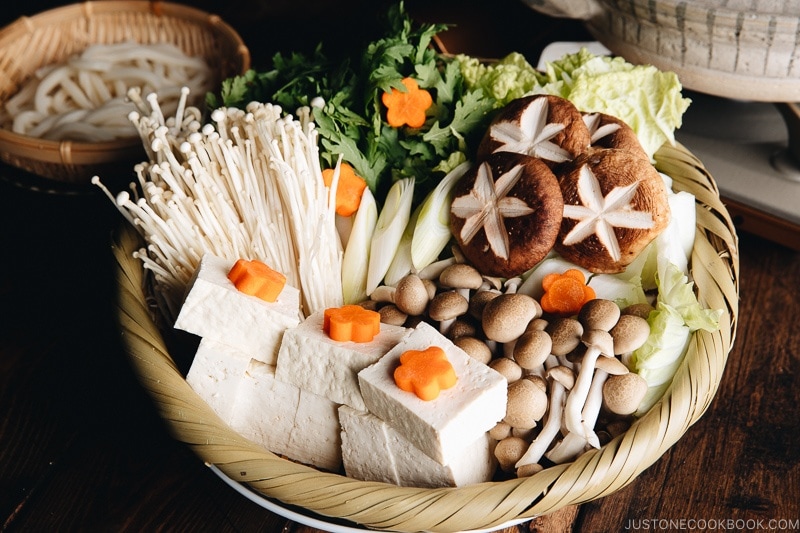
Oh, I love a variety of veggies for my hot pot. Typical Japanese hot pots include napa cabbage, carrot, daikon, sweet corn, lotus root, sweet potatoes, green onions, and shungiku (chrysanthemum greens). However, you can use almost any vegetables you might have in your fridge. Bok choy, broccoli, spinach, or watercress are some easy ones to throw in.
Vegetables cook quickly in the pot, so always include them toward the end of cooking, especially leafy greens.
Mushrooms

Mushrooms are another must-have for hot pot! They add complex, umami flavors and amazing textures to your nabe experience. I love shiitake mushrooms, shimeji or enoki mushrooms, or King oyster mushrooms. More about Japanese mushrooms in this post.
Finishing up with Rice or Noodles


You can enjoy it with a side of hot steamed rice while eating hot pot, but alcoholic drinkers prefer to have their carbs toward the end.
The more common practice would be adding cooked rice or noodles (typically udon) at the end of the meal when most of the meat and vegetables have disappeared.
You can choose to either add the cooked udon to the remaining broth to heat through and enjoy. Or you can add cooked rice with the leftover ingredients to make a super flavorful Zosui (Rice Soup). We call this shime or ‘finish it up’.
Quick Tips to Enjoy Your Nabe

1. Remember the cooking order.
Always start by adding ingredients that enhance the broth’s flavors, such as chicken and fish, followed by root vegetables that take longer cooking time, like potatoes, carrots, daikon, and the thick white parts of napa cabbage. Thinly sliced meat or leafy vegetables cook quickly, so add them last.
2. Fill the pot with the ingredients but do not overcrowd.
Once the broth is boiling, add the ingredients to the pot by arranging them by sections until the pot is filled. Avoid overcrowding the pot as it will cause the broth temperature to drop, resulting a slower cooking time, and some food may not get cooked properly. Remind everyone that we will cook and eat in batches.
3. Skim the broth once in a while.
When cooking proteins (meat and seafood) and vegetables, you will notice foams and scum building upon the surface of the broth. It’s a good idea to skim them occasionally to keep the broth clean. The easiest way to skim is when the broth is boiling. Skimming is usually my responsibility while Mr. JOC adds in the ingredients and keeps an eye on the cooking. Teamwork is always welcome when enjoying a nabemono.
4. Only cook the food you plan to eat.
Unless you’re cooking for yourself, your family, or the kids, make sure to only cook the food you plan to eat. If there’s a piece of fish cake or marbled beef floating in the broth, do not take it out unless it is yours. As a host, you can offer to cook some items for your guests if they are new to hot pot.
5. Add your food only when the broth is boiling.
Ensure that you add ingredients when the broth is boiling and no one is cooking meat at that time because the ingredients you’re adding will cool the broth immediately and stop it from boiling.
As a rule of thumb, be considerate to people around you and ask if you’re unsure what to do. Curious about general Japanese dining etiquette? Here are my posts on Just One Cookbook:
Drinks to Serve with Hot Pot

No hot pot is complete without the company of cold, foamy beer or sake. You can see our Japanese Beer Guide for recommendations.
For non-alcoholic drinks, you can serve nabemono with iced oolong tea, mugicha (barley tea), hot green tea, or hojicha (roasted green tea).
Popular Japanese Hot Pot Recipes to Make at Home
1. Shabu Shabu しゃぶしゃぶ

Shabu Shabu is one of Japan’s most popular communal-style hot pot dishes. Thin slices of meat and assorted vegetables like leafy greens and napa cabbage are cooked in a flavorful kombu dashi broth. Enjoy with different dipping sauces like sesame sauce and ponzu sauce.
2. Yosenabe 寄せ鍋
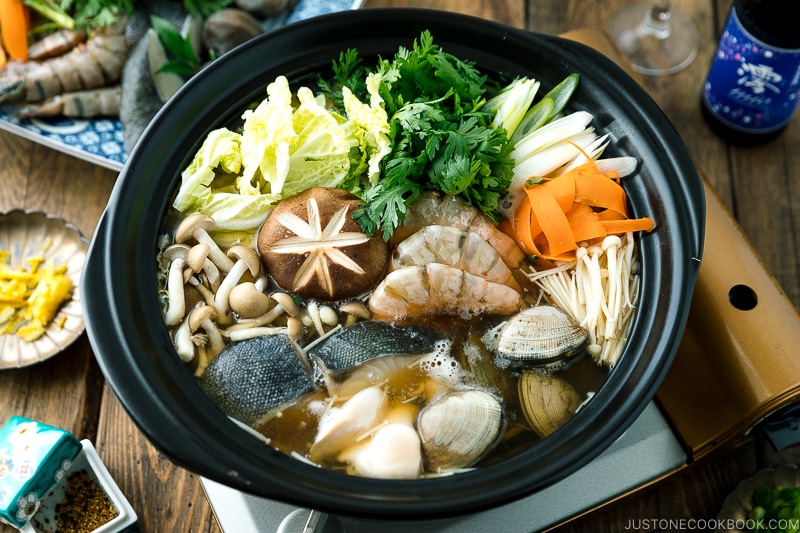
This is the most basic Japanese hot pot where you can cook whatever ingredients—chicken, seafood, tofu, and all kinds of vegetables—in a delicious dashi-based broth.
3. Chanko Nabe (Sumo Stew) ちゃんこ鍋
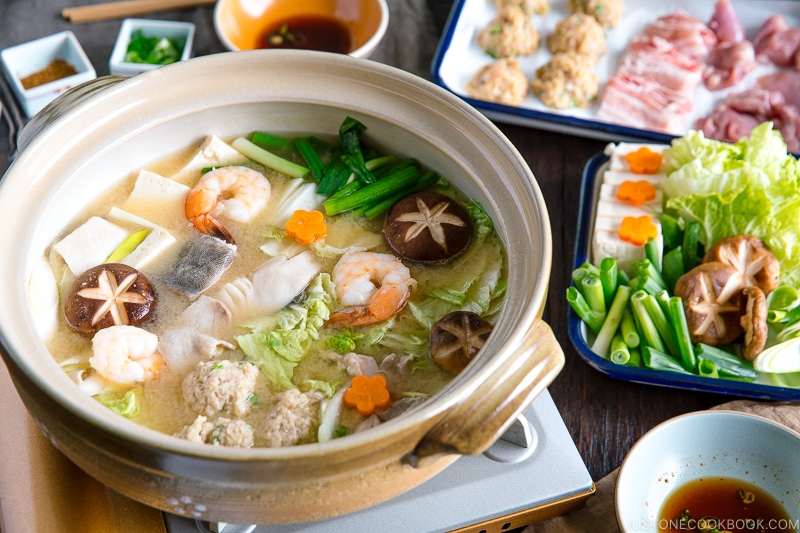
Traditionally eaten only by sumo wrestlers, Chanko Nabe is a robust hot pot filled with all kinds of vegetables and tons of protein in a rich dashi and chicken broth. The original nabe is served with additional ingredients to help sumo wrestlers gain weight, but we have simplified the recipe and kept it well balanced for you to enjoy the hot pot at home.
4. Sukiyaki すき焼き

Served with seared marbled beef and a variety of vegetables in a sweet-salty soy sauce broth, sukiyaki is full of bold flavors. Instead of serving in a donabe, sukiyaki is prepared in a cast-iron pot.
5. Soy Milk Hot Pot 豆乳鍋

Also called the Tonyu Nabe, one of the key ingredients for this hot pot is soy milk, which is used as the main flavoring to the base of dashi broth. Vegetables such as napa cabbage, leafy green vegetables, and thinly sliced pork are then added to cook in the hot pot and dipped in the ponzu sauce to enjoy. The flavor is creamy and savory, with a slightly sweet flavor. A kid’s favorite.
6. Nabeyaki Udon 鍋焼きうどん

Topped with chicken, tempura & heaps of vegetables in an umami dashi soup, this hot noodle soup cooked in a nabe would be your favorite kind of winter comfort food.
7. Mille-Feuille Nabe ミルフィーユ鍋

Inspired by the layering composition of a classic French pastry, Mille-Feuille Nabe is a simple Japanese hot pot made with napa cabbage and pork belly slices cooked in a savory dashi broth. The nabe is very easy to put together, making it one of the most popular hot pot recipes enjoyed at home in Japan.
8. Monkfish Hot Pot (Anko Nabe) あんこう鍋
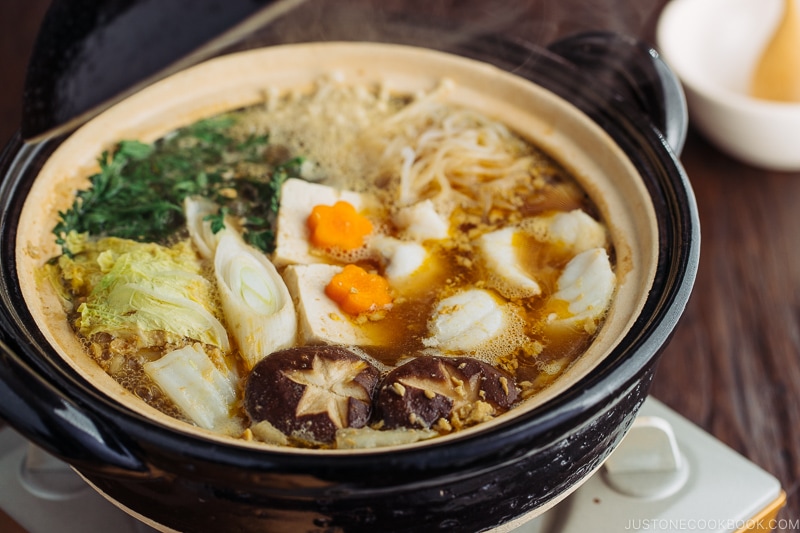
An iconic winter hot pot, especially popular in the eastern part of Japan, Monkfish Hot Pot is the most flavorful nabemono one can make at home. One of the key contributing flavors to the heavenly broth is the steamed monkfish liver. It is the secret ingredient that elevates the soup broth with its unbeatable complexity and depth. No monkfish in your area? You can still cook this nabe with other substitutes such as grouper, halibut, mahi-mahi, sea bass, scallops, snapper, or swordfish.
9. Yudofu (Hot Tofu) 湯豆腐

Light and healthy, yudofu is an incredibly easy, vegetarian-style nabe, featuring dashi kombu and tofu. You can enjoy hot tofu as an appetizer, side dish, or simply a meal on its own.
10. Hot Pot for One 白菜と豚バラの一人鍋
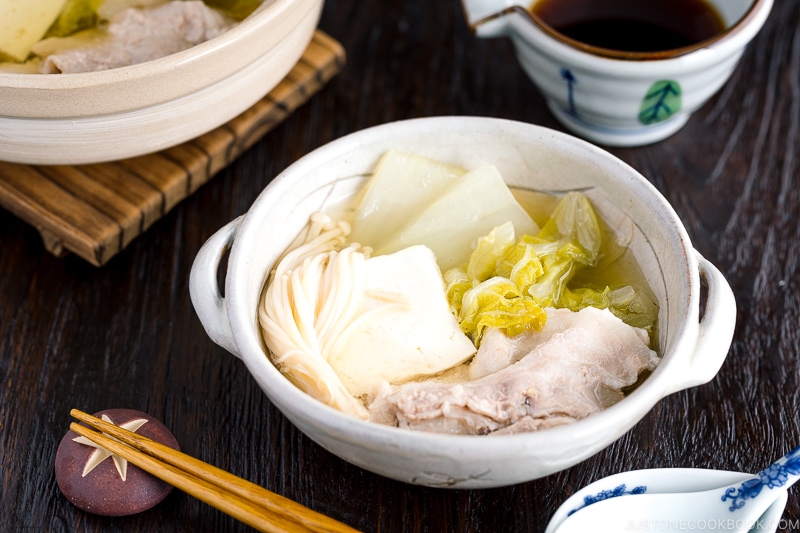
If you’re cooking for yourself, you have more reason to eat better with this Napa Cabbage and Pork Belly Hot Pot. It’s fast, easy and nutritious, and guaranteed to keep you warm and happy.
11. Kimchi Gyoza Nabe キムチ餃子鍋

Cooked in a Korean-inspired, spicy kimchi base, this nabe is filled with succulent Japanese dumplings, spicy kimchi, tender vegetables, and hearty mushrooms. It’s a simmering bowl of savory deliciousness!
12. Sesame Miso Hot Pot 胡麻味噌鍋

Loaded with vegetables, mushrooms, and tofu, this Japanese Sesame Miso Hot Pot is full of umami’s punch. For a vegan version, leave out the meat and throw in more vegetables. The broth is made with kombu and shiitake dashi seasoned with savory miso and sesame seeds.
13. Hokkaido Salmon Hot Pot 石狩鍋

known as Ishikari Nabe, this hot pot is a beloved regional dish from Hokkaido. In this recipe, salmon, potatoes, corn, daikon radish, onion, and cabbage are cooked in a savory miso-based broth and topped with butter for a rich and creamy finish.
14. Mizutaki (Chicken Hot Pot) 水炊き

This hearty hot pot features tender chicken, assorted vegetables, mushrooms, and tofu. On the side, we often serve it with a ponzu sauce for dipping.
15. Tsukune Hot Pot 鶏つくね鍋

This hot pot recipe features ginger-flavored chicken meatballs, along with a healthy mix of tofu, vegetables, and mushrooms, all simmered in a dashi-based hot pot broth.
16. Mizore Nabe (Hot Pot with Grated Daikon) みぞれ鍋

With napa cabbage, fried tofu, mushrooms, and mochi simmered in kombu dashi, Mizore Nabe is a Japanese hot pot cooked with grated daikon. The white radish resembles the winter sleet, of which the hot pot gets its name.
Happy Hot Pot Cooking!
I hope you’re ready to get started on cooking nabemono dishes at home. You’ll find more detailed instructions on how to prepare each specific dish on the individual recipe post itself.
Do you have any favorite nabemono dishes you love to make? I’d love to hear from you. Happy nabe-cooking!
Wish to learn more about Japanese cooking? Sign up for our free newsletter to receive cooking tips & recipe updates! And stay in touch with me on Facebook, Pinterest, YouTube, and Instagram.

Editor’s Note: This post was originally published on March 5, 2019. It was republished in November 2021 with updated content.








These recipes looks wonder!
Hi Martha! Thank you for reading Nami’s post!
We hope you enjoy the variety of Hot Pots this season.
Happy Cooking!
Great recipes
Hi Monica! Thank you very much for reading Nami’s post and for your kind feedback! 🤗
Happy Cooking!
It looks amazing and I want to try them all!
Hi Elaine! Thank you for your kind words!
We hope you liked them all! 😊
Happy Cooking!